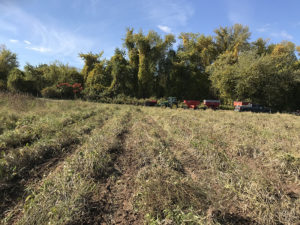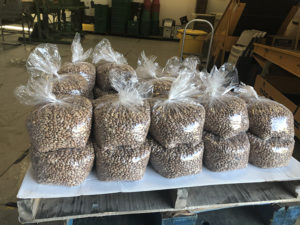(Spanish translation to follow/traducción en español abajo)
Here at the farm, we are growing edible beans as a substitute for soybeans in our field crops rotation. Last season, the Field Crops team planted and harvested a variety of dry beans including navy, black turtle, and pinto beans. Among them, pinto beans were the most widely grown and also performed the best.

“The pintos were less weedy, so we planted more in volume–plus they seemed to perform well,” says Jay Goldmark, the fields crops production manager. “We’re looking to substitute edible beans for food in the crop rotation in place of soybeans destined for livestock feed.”
Planted with the same equipment we use for corn and soy, pinto beans take an estimated four months to grow. The harvest involves a multistep process. As a “dry bean” (beans produced in pods and members of the legume family), the plant has to be dry in order to go through the combine. There are several techniques for drying beans including running an undercutter just below the ground, which cuts the stems from the root structure, thus killing and drying down the plant. Another method is windrowing the beans, letting them dry in rows, and picking them up later with the combine.
After the harvest, the beans are cleaned. This involves running them through a standard grain cleaner called a “clipper” with various sized screens that filter out dirt, stems, stones, and other debris. Beans are then sorted, eliminating those that are cracked or too small. Finally, they are stored in sacks. Once dried to below 14 percent moisture, the beans should keep for at least a year in storage.
 The magic of dry beans is the simplicity they offer as a food source.
The magic of dry beans is the simplicity they offer as a food source.
Pinto beans are a staple food in Mexico and in most Central and South American countries. In Mexico, for example, they are often are mashed and refried and used to fill burritos. The Spanish term frijoles pintos (painted beans) is befitting as it describes their mottled skin, which transforms into a light red when cooked.
The Farm Hub is looking forward to expanding the quantity and varieties of dry beans grown on the farm this year. Farm Manager Eddie Clevenger is optimistic. “Dry beans used to be part of a normal crop rotation, but over time they’ve been replaced by soybeans and other crops that are less risky and that involved less processing. They can be a challenge, especially when it comes to moisture, but we are enthusiastic about working to grow beans without synthetic inputs and within the context of the Farm Hub’s efforts to reduce tillage,” he says.
Update: In late May we planted more dry beans in response to the increased food donation demands related to the COVID-19 crisis. The beans include pinto beans and black turtle beans. All of the dry beans from the 2019 harvest have been donated.
–Amy Wu
Los frijoles pintos en el rancho
Aquí en el rancho, estamos sembrando frijoles comestibles para sustituir la soya, como parte de nuestra rotación de cultivos. La temporada pasada, el Equipo del Cultivo de Frijoles sembró y cosechó toda una variedad de frijoles secos que incluyó frijoles blancos (navy), negros (black turtle) y pintos. De todos ellos, los frijoles pintos fueron los más ampliamente cosechados y los que nos salieron mejor.

“Los pintos fueron a los que les salieron menos maleza, así que los sembramos en un volumen más grande –además, al parecer nos salieron muy bien–”, dice Jay Goldmark, el gerente de Producción del Cultivo de Frijoles. “Queremos sustituir frijoles comestibles, como alimento en la rotación de cultivos, en lugar de la soya destinada a ser pienso de ganado”. Sembrados con el mismo equipo que usamos para el maíz y la soya, los frijoles pintos toman unos cuatro meses para crecer. La cosecha es un proceso de múltiples pasos. Ya que es un “frijol seco” (frijoles que se producen en vainas y son miembros de la familia de legumbres), la planta tiene que estar seca para pasarla por la máquina cosechadora. Hay varias técnicas para secar frijoles que incluyen pasar un cortador justo por debajo de la tierra que separa los tallos de las raíces, terminando por matar y secar a la planta. Otro método es hacer hileras de frijoles, dejándolos secar en filas y recogiéndolos luego con la cosechadora.
Después de la cosecha, se limpian los frijoles. Esto requiere pasarlos por un limpiador de granos estándar, conocido en inglés como la clipper que trae coladores con hoyos de distintos tamaños para filtrar la tierra, los tallos, las piedras y otros materiales. Entonces, se separan los frijoles, eliminando los que tengan grietas o los que sean muy pequeños. Finalmente, se amontonan en pilas. Una vez se secan y alcanzan 14 por ciento de humedad, los frijoles deben guardarse en un almacén por un mínimo de un año.
 La magia de los frijoles secos es la simplicidad que ofrecen como fuente de alimento.
La magia de los frijoles secos es la simplicidad que ofrecen como fuente de alimento.
Los frijoles pintos son una comida típica en México y la mayoría de los países de América Central y América del Sur. En México, por ejemplo, a menudo se hacen puré y se refríen para rellenar burritos. El término “frijoles pintos” es un nombre que les queda como anillo al dedo, porque describe su piel manchada, como si estuviera pintada, la cual se transforma en un color rojo claro cuando se cocinan.
Farm Hub anticipa expandir la cantidad y las variedades de frijoles secos que se cultivarán en el rancho este año. El gerente del Rancho, Eddie Clevenger, se siente optimista. “Los frijoles secos solían ser parte de una rotación normal de cultivos, pero con el tiempo han sido reemplazados por la soya y otros cultivos que son de menos riesgo y que requieren menos procesamiento. Pueden ser difíciles de cultivar, especialmente cuando se trata de la humedad, pero nos entusiasma trabajar en el cultivo de frijoles sin el uso de sintéticos como parte de los esfuerzos de Farm Hub por reducir la labranza”, dice.
Últimas noticias: En mayo, sembramos más frijoles secos en respuesta a una mayor necesidad de donaciones de alimentos debido a la crisis de COVID-19. Los frijoles incluyen pintos y negros. Todas las variedades secas de la cosecha de 2019 han sido donadas.
–Amy Wu
